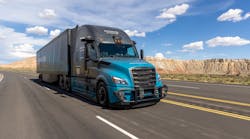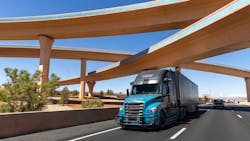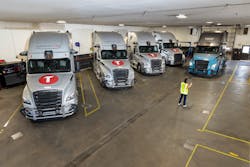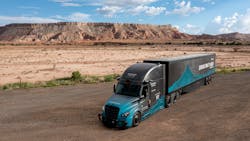ALBUQUERQUE, New Mexico—At a converted Dodge dealership, in the shadows of the Sandia Mountains, engineers and truck drivers are fine-tuning a product that could change the supply chain: combining advanced artificial intelligence software with the hardware of a Class 8 tractor.
Andrew Culhane, Torc Robotics’ chief strategy officer, said his company’s software, combined with Daimler Trucks’ hardware, is creating “an overall system that will empower fleets to run a fully enabled self-driving truck, hub-to-hub or within their network. That’s what we’re looking to get out here.”
Dressed in a Torc-Daimler hoodie on a chilly New Mexico morning in mid-November, Culhane spent the day with FleetOwner, showing off its testing facility here and sharing his company’s vision of a future where robotic tractors constantly run, moving freight across the U.S. A couple of years ago, Daimler Trucks acquired a majority stake in Torc Robotics, which has been developing autonomous technology for 15 years.
While Torc still operates independently, Culhane notes that the two companies are working together to develop that future fleet product. “You need that close integration with the chassis, that feedback to be able to operate in those high dynamic environments to have that safety, that reliability in there,” he said of the hardware-software partnership. “That’s been huge. Ultimately, when we think about bringing a product to market, it’s more than just software. It’s actually bringing all these elements together: the chassis, the computers, the sensors, all that hardware, all those things need to come together simultaneously.
“While software can iterate on faster cycles, automotive-grade hardware, and more importantly, the million-mile trucking grade hardware, takes time to develop. That’s something that Daimler is fantastic at—and we leverage that partnership very closely.”
Most autonomous trucking startups are testing their self-driving software in Texas, hauling actual freight. Founded in 2005, Culhane is quick to point out that Torc is “not a startup.” With the backing of one of the largest truck makers in the world, all the Torc-powered Freightliner Cascadias have to haul now is trailers full of cement blocks. Its primary focus is developing that future fleet product.
‘Why in the world are we here in Albuquerque?’
With its headquarters still in Blacksburg, Virginia, the Torc testing facility in New Mexico was created just to develop that fleet product. “You’ll see engineers, you’ll see other folks—but ultimately, this shop is built to run testing day in and day out,” Culhane said as he walked around the former showroom floor that is now mission control for Torc’s fleet of test tractors.
Torc conducts two test shifts per day that involve multiple trips in trucks in the Albuquerque region. There are about a dozen tractors on-site. Culhane declined to share Torc’s total fleet size.
“From the fleet side, there’s the immediate question: Why in the world are we here in Albuquerque? We’re used to that question,” he said. “All the fleets that we’ve had out here always ask the same question.”
Culhane’s answer: “This is a product development facility. Obviously, a lot of freight moves across (Interstate) 40. But this is not trying to mock up a logistics center. So really, the focus is on product development testing. We are out seeing the unique, interesting, dynamic situations that inform our next steps of development to ultimately release a driverless truck product.
“If you've got a chance to drive around Albuquerque a little bit, there's a lot of varied intersection types. You can go from dense urban traffic, where the I-25 and I-40 merges, all the way to, we'll say, high-dynamic, up-and-down, steep hills out to the east.”
After searching along some 3,000 miles of freight lanes crisscrossing the Southwest, “this really made the most sense for us,” Culhane said.
Albuquerque isn’t illogical. It’s in the rather friendly New Mexico climate, desert lands surrounded by mountains. The I-25-I-40 interchange—known locally as the “Big-I” is just a mile from the Torc testing facility, the former car dealership vacant for a decade before Torc converted into a high-tech trucking test lab.
Inside the facility, it still looks like Torc is moving in. Doors lean against walls, waiting to be installed in conference rooms. Boxes are waiting to be unpacked. As COVID-19 restrictions ease, Torc engineers and other staff regularly fly in and out of ABQ from the Blacksburg headquarters, Daimler’s North American headquarters in Portland, Oregon, and Daimler AG’s Stuttgart, Germany, base.
Engineers sit in desk pods on one side of the large former car showroom floor. On the other side is Torc’s mission control, where nine large flat-screen monitors clustered together show a live look at Torc’s test fleet. Near the giant monitor are couches and comfy-looking chairs, where the team can track the test trucks’ movements.
“Right up the street, we test north, south, east, west from here,” Culhane said. “That gives us a lot of varied conditions—both on-highway and off-highway. So it’s just proven to be a really great place. We obviously have trucks in other locations as well. But a lot of our testing is running out here.”
I-40, the longest southern interstate highway in the U.S., parallels historic Route 66. One hundred forty miles to the west, the road reaches a 7,275-foot elevation. Two-hundred-forty to the south of I-40, I-25 connects with Interstate 10, another major East-West freight corridor.
While I-40 could offer Torc long runs, the Albuquerque metro area is a perfect real-world lab for future trucks, Culhane explains. “We can drive all the way to Texas—but, quite honestly, once you get a few miles outside of the city, it’s two lanes, straight and flat,” he said. “And while that’s great to say we can drive a lot of miles, you’re not learning a lot. You want to see all the different interchanges. You want to see the different merges, lane changes, traffic conditions, good and bad drivers. Albuquerque is regularly in the top 10 of the worst places to drive. So we take advantage of that here.”
Torc employees shared stories of encountering horses on the highways. On Halloween, an autonomous truck encountered a person dressed as the Burger King running along I-40. Another day, a self-driving truck passed by a man alone with a pickup truck, shovel, and gravel, filling potholes along the highway. He did not appear to be with a local or state agency. He just ran out onto the divided highway with his shovel filled with asphalt.
The weird sightings aside, in and around Albuquerque, the roads are busy. Culhane said, “there is no rush hour” in the city. It’s just always busy. The Big I handles more than 200,000 vehicles on both I-25 and I-40 on average each day. That’s more than 400,000 vehicles, which is more than two-thirds of Albuquerque's population.
“Most of the people driving I-40 are going through it,” Culhane said. “So you see a lot of varied people that don’t know the roads every day. It’s not like driving around D.C., where everybody lives there.”
Robotic truck testing
Outside the city, along I-40, trucks make up 30% to 40% of the traffic, according to a 2017 New Mexico DOT study. The Torc trucks are tested in that heavy truck traffic as a driver and safety conductor oversee its autonomous operations along the steep hills and twisty roads outside the city, often battling heaving crosswinds.
“From our view, it allows us to develop for really critical on-highway safety situations. Then we’ll layer in more and more of our off-highway type of driving technology that we’ve been developing that for the last decade-plus.”
The Torc facility in Albuquerque runs like a fleet, according to Klara Oberhollenzer, Torc’s mission control product director, a German native who has worked for Daimler since 2015. “Mission control is the connection between the virtual driver and any human,” she told FleetOwner. “What we really believe is that this virtual driver that we're developing needs to be something that humans can interact with without having a software development degree.”
The system looks like a typical telematics system, showing where all the fleet vehicles are at any moment and if it’s in robotic or manual driving modes. “We treat the test like a load. We use it for data collection,” Oberhollenzer said as she pointed to the large mission-control screens. “All of these flags are specific data points. But talking about where we want this to go and why we think this is needed: Our vehicle will need some support from humans. It will need some supervision and direction on the road for known situations—but also for unknown situations.”
As COVID-19 travel restrictions lifted this year, more Torc engineers from Virginia and elsewhere have visited the facility to get actual experience in the trucks. “This group here of engineers are from other locations,” Culhane said, pointing to the workstations on one side of the former car dealership. “Getting them here, getting them in a truck, having them talk to the drivers, and building that close connection. If you’ve never been in an 80,000-lb. trucking going down the road, you really can’t visualize it. You can’t understand it in simulation. So it’s good to get everybody here. That close connection with the drivers is important. Hearing from them, ‘Hey the truck behaved this way,’ ‘Hey I would drive that way.’”
Every driver and safety conductor checks in each day with the ops center to discuss the previous day’s autonomous driving “to talk about what went well, what didn’t, and the updates for the day,” he said. “We have some amazing drivers here. They give us a lot of great feedback on how to improve the product. Every drive, even your demo today, is part of that process.”
Creating the self-driving truck product
Torc has recently started inviting fleets to visit its facilities to not only show off what they offer but to learn more about what fleets want and how to keep operational costs reasonable.
“We’re making sure we do that in the smartest way possible, engaging with fleets very early on to find out what works operationally,” Culhane said. “We’re seeing some of them add more technology throughout the process. So there’s that timing horizon of making sure we bring the right technology at the right time to integrate with what they’re planning.”
At other facilities, Torc is testing off-highway robotic driving for its eventual “hub-to-hub” product offering. While those other tests focus on autonomous driving with traffic lights and more turns, the Albuquerque tests or focusing on the “challenging, higher-speed truck problems,” Culhane explained.
“When you think about self-driving, distance and density aren't your main factors. It's going to be more what you would call ‘road network structure,’” he said.
Culhane said the Torc Robotics product will focus on “good clean access on and off” the highway, with few pedestrians, and “well-marked roads, designed well for trucks.”
While typically, these hubs are located on the edges of cities, allowing trucks more room to operate—but close enough to populations centers.
What these Torc-controlled Freightliner Cascadia prototypes are capable of now “is just the tip of the iceberg,” Culhane says. “There are all those other things that are going to make this great technology become a great product.”
Maintaining million-mile autonomous trucks
The second-generation Torc trucks are focused more on “serviceability, maintainability, understanding what it's going to take to go from some of these more prototype sensors to truly having a rugged, truck-ready system,” Culhane explained on a chilly Albuquerque morning as he walked among his fleet of tractor-trailers on the Torc lot.
“These are work trucks. They are million-mile assets. We’re understanding what that’s going to take from a ruggedness and reliability perspective,” Culhane says. “We’re also having those conversations with the fleets, with the dealers, to say how we are going to service these things and think through all of that.”
In the future, when autonomous trucks don’t have safety drivers and aren’t required to follow federal hours-of-service rules, they’ll likely reach 1 million miles in three to 3.5 years, Culhane said. That will have a significant impact on maintenance. “You could say a great self-driving vehicle gets less wear-and-tear because of its efficiency—but you’re driving two to three times as much.”
To plan for that future, Torc is using data and analytics gathered during its 15-year history, along with other implementations besides over-the-road trucking. “There are other models out there for this,” Culhane explained. “Whether it’s mining in other areas where automation has already been implemented, using data analytics, getting that predictive maintenance schedule even tighter is great.”
That serviceability comes with more modular designs for the sensors and other components that will allow technicians to swap them out. “If all the technology ends up being safe and able to go down the road, the differentiator is going to be on those things that affect TCO, that affect uptime,” Culhane explains on what he hopes will differentiate Torc from other AV trucking companies. “So serviceability and reliability are big factors.”
Torc trucks’ technology
The Torc sensor suite includes traditional radar and lidar, imaging radar, and “ultra, long-range lidar sensors” from Luminar, a Daimler partner. It is also equipped with HD cameras and other radar sensors, “really giving that redundant, full-picture of the world,” Culhane says.
Redundancy is essential, particularly if autonomous trucks are going to extend beyond the Southwest. “Driving on the East Coast, it’s not 65 and sunny every day. Trucks don’t get to stop because it’s misting. So we’re making sure that we have the level of redundancy and reliability in the sensor suite to operate in a relevant set of conditions.”
Redundancy isn’t just about the high-tech components on the outside of the truck. While there is a safety driver in every test Torc conducts, it plans to run the robotic trucks with no humans onboard one day.
“When you think about what it's going to take to get the driver out of there, right now, the driver’s there as the backup. For any systems that fail, they can make judgment calls on how to handle a situation,” Culhane explained. “In a self-driving vehicle, there’s not a driver behind the wheel. So if the steering fails, you need redundant steering. If the braking goes out, you need redundant braking. Same thing with power and other systems.”
These tests in Albuquerque are helping inform Torc how to create a “fully redundant chassis.” And the more data Torc collects from inside and outside the tractors, the better its preventative maintenance will become, he added. “We have more data about what's going on. We actually can track way more things about the vehicle, the environment that is encountered. We think there’s a lot of opportunity for better TCO, better return on capital, as we know more of what’s going on on the vehicle every day, every mile it drives.”
Next week: Look for FleetOwner’s firsthand account from inside a self-driving tractor-trailer.







